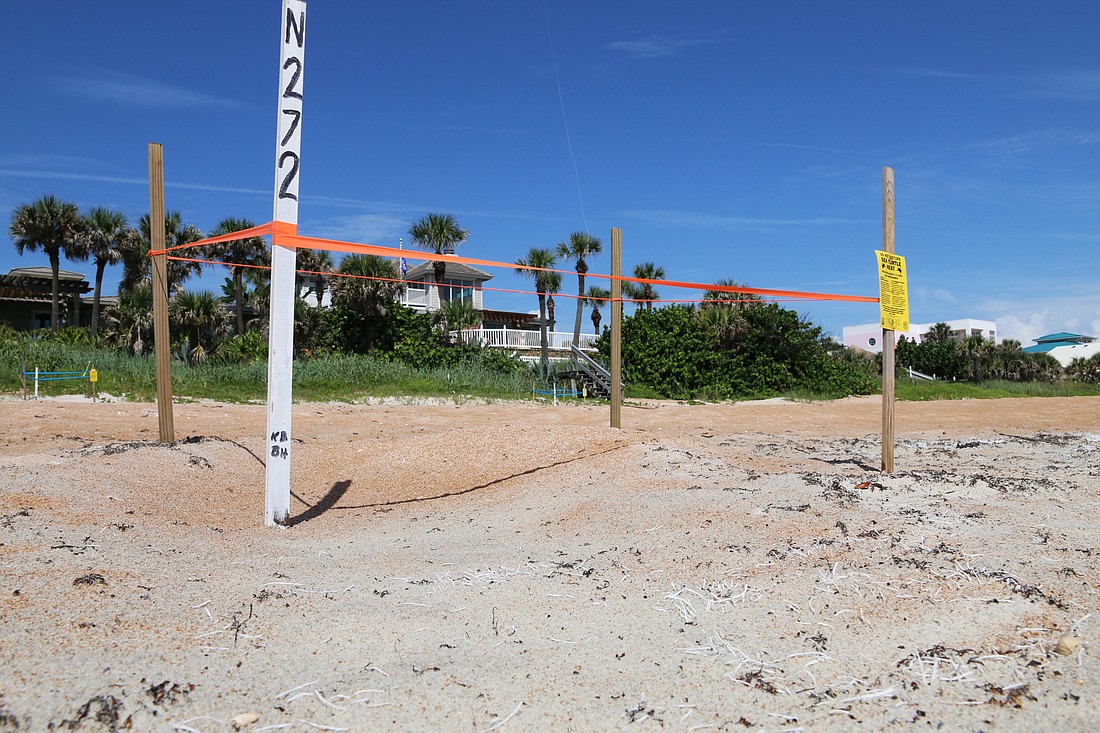- April 19, 2024
-
-
Loading

Loading

Deena Delany loves sea turtles.
It's evident in the way she enthusiastically speaks about the different tracks each species makes on the beach, and in her accessories. She wears dangly silver earrings with sea turtles and in this era of COVID-19, even her mask is sea turtle themed.
Delany is one of about 14 Ormond Beach residents who volunteer with the Volusia Sea Turtle Patrol, a group who monitors and documents sea turtle nests north of Ponce Inlet to Gamble Rogers State Park. During the May 1-Oct. 31 nesting season, the Volusia Sea Turtle Patrol check for new nests every day, rain or shine just after 6 a.m., and keep an eye on existing nests as well.
Usually, the volunteers, who lend their time once or twice a week, are done around noon, but with the high number of nests on Volusia beaches these last couple of years, that's not always the case. Delany once documented 13 new nests in one day, the highest she's ever had.
“There’s days when we don’t get home until three o’clock in the afternoon," Delany said.
Soon, the Volusia Sea Turtle Patrol's efforts will be bolstered with another method of surveillance: Eyes on the sky.
Embry-Riddle Aeronautical University has teamed up with aerospace company Northrop Grumman and the Brevard Zoo to launch a drone project that will help identify individual sea turtles, including their species, gender and unique markings, according to a press release by the university.
The "Turtle Tech" project will not only provide more insight into sea turtle conservation, but it will provide paying jobs for students.
“Students will have hands-on opportunities to work on flight operations, aircraft modifications, payload integration and much more," said John Robbins, Embry-Riddle associate professor of Aeronautical Science in the press release. "This project is a win-win for sea turtles and students.”
In 2019, Volusia saw its highest number of nests on record: 984. This year as of July 31, there have been 857 total nests, with about 700 still incubating on the beach. Peak hatching time is also underway, with 5-15 hatchings a night.
The county's 10-year average is 500 nests a year, said Ryan Chabot, habitat conservation plan manager for Volusia County's environmental management division.
“I don’t that we’ll pass last year, but the biggest thing to do is never count out sea turtles to do the unexpected," Chabot said. "You never know what’s going to happen.”
Tropical Storm Isaias may not have had a major impact to residents, but Chabot said somewhere between 5-20% of the nests on the beach have likely been lost. Survey crews are still re-establishing nest barriers and conducting inspections.
Loggerheads are the most common species to nest on Volusia beaches, followed by green sea turtles and then leatherbacks. Kemp's ridley sea turtle nests are rare. There's only one this year, and since 1996, only 14 have been documented, according to the Embry-Riddle press release; 10 of the 14 were laid by the same three turtles.
The Turtle Tech project will use two types of drones, the Applied Aeronautics Albatross with vertical take-off and landing capability and the DJI Matrice 210, which can capture finer-grain images of the sea turtles.
“The Albatross will do the initial wide-area detection, and then, when we find turtles of interest, that’s when we would use the DJI platform to hover and look at identifying markers like scute patterns on a turtle’s carapace,” said Roddey Smith, a chief engineer and research fellow at Northrop Grumman, in the press release.
This will allow Embry-Riddle researchers and their team to create a sea turtle database without having to apply a tracking device to each turtle. The drones will fly at 200-300 feet above ground, preventing them from disturbing the turtles.
“We see this project as solving real-world problems,” said Keith Winsten of the Brevard Zoo in the press release. “It’s great to build a bridge and put an egg on it, but what are these sea turtles doing in the surf and how does that affect their conservation? That’s the real-world question we need to answer.”
The first test flights should occur in about a month, after students arrive at Embry-Riddle for the 2020 fall semester on Aug. 24.
Delany has been volunteering with the Volusia Turtle Patrol for the last seven years. Her favorite part of the work occurs three days after a nest hatches. That's when they dig up the nests to document how many eggs hatched.
Sometimes, they find live hatchlings and get to release them into the ocean.
What happens when a nest never hatches? Delany said that after 70 days, they will dig them up to see why. Earlier this year, they dug up a nest up in the dunes that had been covered with railroad vine. To the volunteers' surprise, they found 84 live hatchlings.
“I put them in a bucket and they were jumping out of the bucket,” Delany recalled laughing. “But that was just such a thrill, and I released all of them and they all went out to the sea like they should have. That was exciting.”
It's moments like this that make it worthwhile, Delany said. Anything that will help with the conservation of sea turtles, like Embry-Riddle's Turtle Tech project, helps the volunteers, she said.
“It’s a labor of love," Delany said. "It’s a lot of hard work.”